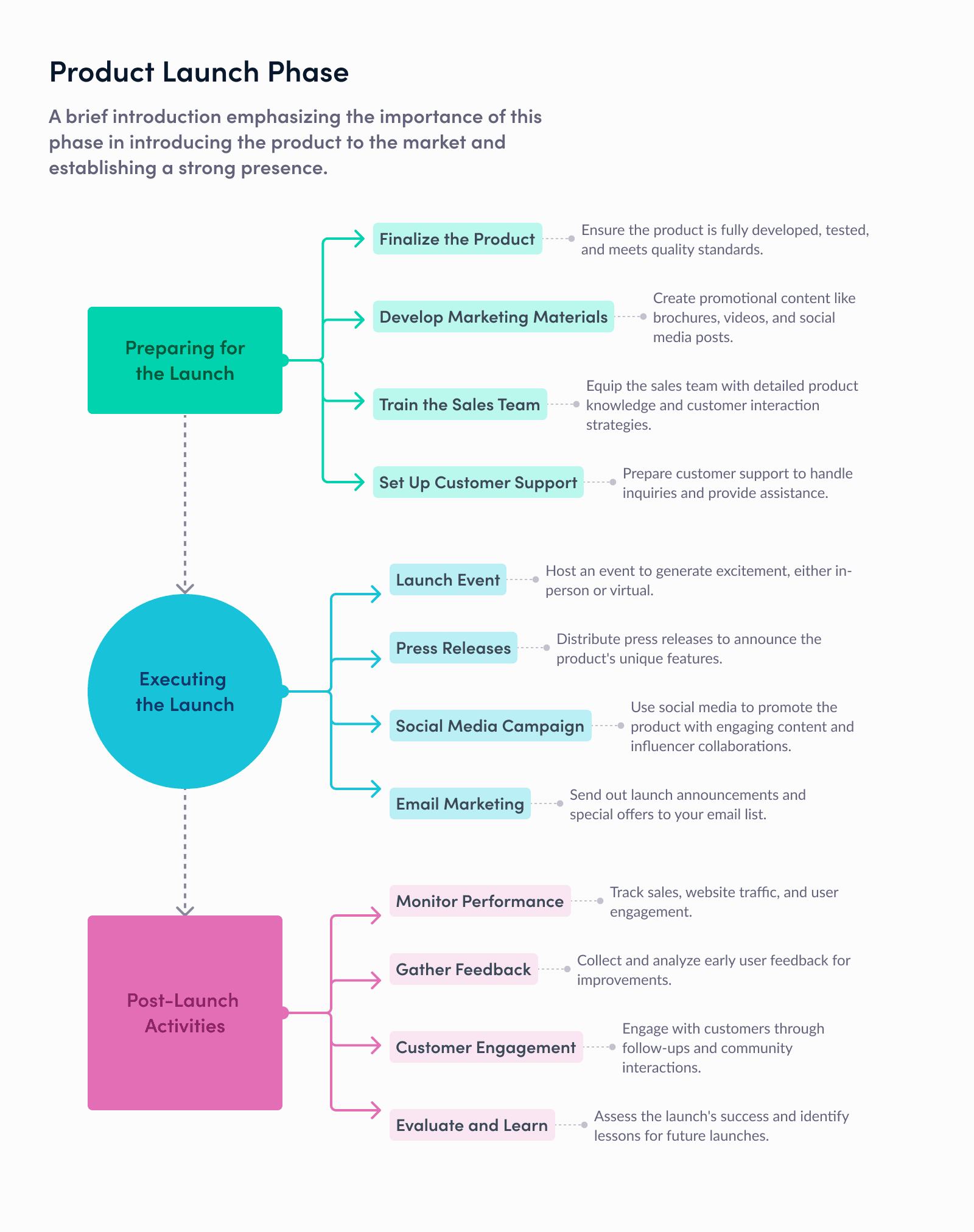Updated: June 16, 2025- 17 min read
Managing multiple aspects of product development can feel overwhelming. Focusing on your core products is vital, but so is staying aligned, agile, and resource-efficient.
This guide breaks down the entire product management process—from market research to roadmapping and prioritization—with clear examples and visuals. Learn how each stage works together to drive growth and innovation while keeping you focused on what matters most.
The 7 Stages of the Product Management Process
The product management process is the structured sequence of steps that guides a product from initial idea to market success and beyond. It ensures that each decision, from understanding customer needs to defining features and prioritizing work, aligns with the company’s strategic goals and delivers maximum value to users. This process combines market research, strategic planning, cross-functional collaboration, and continuous feedback to turn insights into actionable plans and successful products.
By following a clear process, product teams can reduce risks, adapt to market changes, and ensure that every stage—from discovery to launch and iteration—supports growth, innovation, and long-term product success. Creating a successful product involves several important steps. Each stage plays a crucial role in bringing innovative solutions to the market:

1. Product discovery: Idea generation
The Idea Generation stage is the first step in the product development process, also known as Product Discovery. This is, of course, where new product ideas are brainstormed and ‘put on paper’. Unrestrained creativity and innovative thinking are the vital constituents in this phase — they encourage the collection of a wide range of ideas without immediate evaluation or criticism.
How to capture ideas?
To effectively harvest creative concepts, it’s essential to create an environment where creativity can flourish. Here are some methods to help capture innovative product ideas:
Brainstorming Sessions: Organize regular brainstorming meetings where team members can freely share their thoughts. Use techniques like mind mapping and free writing to stimulate creative thinking.
Market Research: Gather insights from market trends, key metrics, product analysis, and industry reports. Understanding market needs and gaps can spark new product ideas.
Customer Feedback: Engage with customers through surveys, interviews, and feedback forms. Customers can provide valuable insights into their needs and pain points.
Internal Suggestion Programs: Encourage all employees, not just those in product development, to contribute ideas. Create a suggestion box or an internal digital platform where ideas can be submitted.
How to make sure everyone’s in the loop?
Once ideas are generated, it’s crucial to document them in a centralized location to ensure they are accessible and not overlooked. This can be done using:
Idea Management Software: Your everyday product management tools or dedicated idea management platforms can help track and organize ideas.
Shared Documents: Use cloud-based documents (e.g., Google Docs, Microsoft OneNote) where team members can add and edit ideas in real time.
Idea Boards: Physical or digital idea boards can be used to visualize and categorize ideas.
Don’t judge, collect!
During the Idea Generation stage, the emphasis should be on quantity rather than quality. This is not the time for screening or criticism. The goal is to gather as many ideas as possible, which increases the likelihood of finding innovative solutions. Encourage team members to think outside the box and not fear sharing unconventional ideas.
Lay down the law.
To ensure ideas are well-developed and actionable, establish a set of guidelines for idea submission. These guidelines can include:
Elaboration: Ideas should be detailed enough to understand their core concept. Include descriptions of what the idea entails and how it functions.
Impact Potency: Assess the potential impact of the idea. How significant is the problem it addresses, and what benefits will the solution provide?
Channels Encompassed: Identify which channels (e.g., digital, retail, B2B) the idea affects or leverages.
Problem-Solving: Clearly state the problem the idea aims to solve. Define the target audience and their specific pain points.
Complexity: Evaluate the complexity of developing the idea. Consider the technical feasibility, required resources, and time to market.
By following these guidelines and fostering a creative, inclusive environment, the Idea Generation stage can produce a wealth of innovative ideas that serve as the foundation for successful product development.
Free Value Proposition Canvas
Learn how to take user problems as the foundation of your solution and only build products that matter with our free Value Proposition Canvas!
Get Yours Now
2. Idea screening
The Idea Screening stage is the second step in the product development process. Here, the initial pool of ideas is evaluated to weed out the less promising ones. This phase ensures that only the most viable and valuable ideas move forward. This is where you get to be critical!
Remember though, all ideas are created equal.
It's crucial to treat all ideas equally during the screening process. Every idea, regardless of its source, should undergo the same evaluation scrutiny. This prevents bias and ensures that only the best ideas are selected based on their merit, not credit.
Product teams often make the mistake of allowing ideas from top management to bypass the screening process. This practice can lead to suboptimal decisions and missed opportunities. It is best if all ideas, whether from top management or entry-level employees, are evaluated using the same criteria.
Speaking of criteria…
Here are some key criteria to use when screening ideas:
Market Potential: Assess the potential demand for the idea. Does it address a significant need or gap in the market?
Feasibility: Evaluate whether the idea is technically and financially feasible. Do you have the resources and capabilities to develop it?
Alignment with Business Goals: Ensure the idea aligns with the company’s strategic objectives and long-term vision.
Competitive Advantage: Consider whether the idea offers a unique advantage over competitors. What sets it apart in the market?
Customer Value: Determine the value the idea provides to customers. Will it enhance their experience or solve a critical problem?
The Screening Process
Initial Review: Conduct an initial review of all ideas to filter out those that clearly do not meet the basic criteria.
Scoring System: Use a scoring system to evaluate each idea against the established criteria. Assign scores based on factors like market potential, feasibility, and alignment with business goals.
Group Discussion: Involve a cross-functional team in the screening process. Discuss each idea to gather diverse perspectives and insights.
Prioritization: Rank the ideas based on their scores and discussions. Focus on the top-ranked ideas for further development.
Feature Prioritization Template
Use this feature prioritization template to get clear direction on which features to include and which to leave out.
Download Free
Tools for Screening Ideas
Evaluation Matrices: Use matrices to compare ideas against each other based on the screening criteria.
Scoring Sheets: Develop scoring sheets to systematically assess each idea's strengths and weaknesses.
Collaborative Platforms: Utilize collaborative tools to enable team discussions and input on each idea.
3. Concept development and testing

The Concept Development and Testing phase comes after Idea Screening and involves transforming selected ideas into detailed concepts. These concepts are then tested with target audiences to gather feedback and refine the product vision. This phase is crucial for ensuring that the product idea is viable and resonates with the intended users.
Concepts need to be detailed.
To develop detailed concepts, follow these steps:
Expand on the Idea: Take the selected idea and expand it into a full-fledged concept. This includes defining the product’s core functionality, features, and user experience.
Create Concept Prototypes: Develop prototypes or mockups to visualize the concept. These can be low-fidelity sketches or high-fidelity digital prototypes, depending on the stage of development.
Describe the Value Proposition: Clearly articulate the value proposition of the prototype or MVP. What problem does it solve? What benefits does it offer to users?
Outline the User Journey: Map out the user journey, detailing how users will interact with the product from start to finish. Identify key touchpoints and potential pain points.
Testing with target audiences
Once the concepts are developed, they need to be tested with target audiences to validate their feasibility and appeal. Here’s how to conduct effective concept testing:
Identify Test Participants: Select a representative sample of your target audience for testing. Ensure diversity to gather a wide range of feedback.
Conduct User Research: Use surveys and one-on-one interviews to gather qualitative and quantitative feedback. Ask participants about their first impressions, perceived value, and any concerns or suggestions.
Utilize Usability Testing: Conduct usability tests where participants interact with the prototypes. Observe their behavior and gather feedback on the user experience.
Analyze Feedback: Collect and analyze the feedback to identify common themes, preferences, and areas for improvement. Look for patterns that indicate the concept’s strengths and weaknesses.
Refining the Product Vision
Based on the feedback gathered, refine the product vision and concept. This iterative process ensures that the product meets user needs and expectations. Key steps include:
Incorporate Feedback: Adjust the concept to address the feedback received. This might involve adding new features, improving usability, or altering the design.
Re-evaluate Feasibility: Ensure that the refined concept is still feasible within the project’s constraints, including budget, timeline, and technical capabilities.
Iterate on Prototypes: Develop new prototypes based on the refined concept and conduct additional testing if necessary. Continue refining until the concept is well-received by the target audience.
Align with Business Goals: Make sure the refined concept aligns with the overall business goals and product strategy. Ensure it contributes to achieving the desired market position and business objectives.
4. Product specifications
The Specification phase follows the conceptualization phase in the product development process. This phase involves detailing the selected ideas into comprehensive product specifications, which serve as a blueprint for the development team. Detailed product specs provide clear guidance, ensure alignment and communication, reduce risks, and establish quality assurance criteria.
What are Product Specifications?
Product specifications, or product specs, are detailed documents that outline the features, functionalities, design, and requirements of a product. They provide a clear and concise description of what the product is, what it will do, and how it will be built.
Questions to answer in Product Specifications
To create thorough product specifications, answer the following key questions:
What is the product? Describe the product in detail. What is its purpose? What problem does it solve?
Who is the target audience? Identify the end users. Who will use this product? What are their needs and pain points?
What are the key features and functionalities? List the primary features and functionalities of the product. What must the product be able to do?
What are the design requirements? Specify the design aspects, including user interface, aesthetics, and user experience considerations.
What are the technical requirements? Outline the technical specifications, such as platform compatibility, performance criteria, and security requirements.
What are the constraints and limitations? Identify any constraints, such as budget, timeline, regulatory requirements, and technical limitations.
How will success be measured? Define the metrics and criteria for success. How will you know if the product meets its objectives?
Know how to write product specifications
When writing product specifications, follow these guidelines to ensure clarity and completeness:
Be Detailed and Specific: Include all necessary details to avoid ambiguity. The more specific you are, the easier it will be for the development team to understand and implement the requirements.
Follow a template: Start with a template that covers all basis in order for the products specs to be detailed and digestible.
Organize Logically: Structure the document in a logical order. Start with an overview and business case then dive into specifics like features, design, and technical requirements.
Include Visuals: Use diagrams, flowcharts, and sketches to illustrate complex concepts and designs. Visuals can help communicate ideas more effectively.
Collaborate with Stakeholders: Involve key stakeholders in the specification process to ensure that all perspectives are considered and that the specs align with business goals and user needs.
By following these steps, you ensure that your product specifications provide a solid foundation for the development stages that follow. This leads to more efficient development, higher quality products, and greater success in the market.
5. Product strategy and roadmapping
The Product Strategy and roadmapping phase involves creating a strategic plan and a detailed roadmap that guides the product from development to launch and beyond. The strategy and roadmap ensure that the product aligns with business goals, meets market demands, and is delivered on time.
Define Product Strategy
Product Strategy is the high-level plan that outlines what the product aims to achieve and how it will do so. It provides direction and sets priorities for the product team. Aside from knowing essential frameworks and using templates, you should know the key components of a product strategy:
Vision and Mission: Define the long-term vision for the product and its mission. What is the ultimate goal of the product? What problem does it aim to solve?
Market Analysis: Conduct a thorough market analysis to understand the competitive landscape, market trends, and customer needs. This helps identify opportunities and threats.
Target Audience: Clearly define the target audience for the product. Who are the primary users? What are their characteristics, needs, and pain points?
Unique Value Proposition: Identify what makes the product unique and valuable compared to competitors. Why should customers choose your product?
Business Objectives: Set clear business objectives that the product aims to achieve. These could include revenue targets, market share goals, or customer satisfaction metrics.
Product Positioning and Messaging: Develop a positioning statement and key messages that communicate the product's value to the target audience.
Creating a Product Roadmap
A product roadmap is a visual, detailed representation of the product strategy. It outlines the planned features, milestones, and timelines for the product’s development and launch. Here’s how to create an effective product roadmap:
Set Goals and Objectives: Start by setting clear goals and objectives for the product. These should be aligned with the overall product strategy and business objectives.
Prioritize Features: Based on the product specifications, prioritize the features and functionalities to be developed. Consider factors like customer needs, business value, and technical feasibility.
Define Milestones: Break down the development process into key milestones. These are significant points in the project timeline that indicate progress, such as completing a prototype or reaching beta testing.
Establish Timelines: Set realistic timelines for each milestone and feature. Consider the resources available and potential risks that could impact the schedule.
Visualize the Roadmap: Use a visual tool to create the roadmap. This can be a Gantt chart, a timeline, or a Kanban board. Ensure it is clear and easy to understand for all stakeholders.
Communicate and Collaborate: Share the roadmap with all relevant stakeholders, including the development team, marketing, sales, and upper management. Gather feedback and make adjustments as needed.
Review and Adjust: Regularly review the roadmap to track progress and make necessary adjustments. The roadmap should be a living document that evolves with the project and market conditions.

Creating a product strategy and roadmap ensures alignment and focus among team members and stakeholders, providing clear direction on what needs to be built and when. It's important to study examples of product roadmaps to see which type best facilitates efficient resource allocation for your team by prioritizing features and setting realistic timelines while also identifying potential risks early for proactive mitigation. Additionally, it enhances communication and collaboration, offering a shared understanding of the product’s progress and goals.
Product Roadmap Template
Download our easy-to-use template to help you create your Product Roadmap.
Get the Template
6. Agile product development
The Agile Product Development phase focuses on iterative and incremental development, ensuring that the product evolves through continuous collaboration, feedback, and improvement. Agile methodologies prioritize flexibility, customer satisfaction, and delivering working software frequently.

Adopting Agile methodologies
Agile product development relies on specific methodologies to manage and execute the process effectively. The most common methodologies include Scrum, Kanban, and Extreme Programming (XP).
Scrum: Scrum divides the development process into time-boxed iterations called sprints. Each sprint typically lasts two to four weeks and involves planning, execution, review, and retrospective phases.
Kanban: Kanban focuses on visualizing the workflow, limiting work in progress (WIP), and improving efficiency. It uses a column-based board to track tasks and progress.
Extreme Programming (XP): XP emphasizes technical excellence and good programming practices, such as pair programming, test-driven development (TDD), and continuous integration.
Key Principles of Agile Product Development
Customer Collaboration: Agile development emphasizes close collaboration with customers and stakeholders to gather feedback and ensure the product meets their needs.
Iterative Development: Development occurs in small, manageable increments. Each iteration results in a potentially shippable product increment.
Responding to Change: Agile methodologies embrace changes in requirements, even late in the development process. This flexibility allows the product to adapt to evolving market needs and customer feedback.
Agile product development keeps customers satisfied by involving them throughout the process. It's flexible and adapts easily to new information and market changes.
Agile also speeds up delivery with incremental development and frequent releases. It promotes better collaboration among developers, stakeholders, and customers. Regular feedback and retrospectives help continuously improve the product and team performance.
7. Product launch

The Product Launch phase is the culmination of all the hard work put into developing your product. This stage involves introducing the product to the market and ensuring that everything is in place for a successful launch. A well-executed product launch plan can generate excitement, drive sales, and establish a strong market presence.
Product Launch Checklist
Launch is a critical time that can make the difference between product success and failure. Use this checklist to make sure nothing falls through the cracks.
DOWNLOAD CHECKLIST
Preparing for the launch
Before launching your product, thorough preparation is crucial. This ensures that all aspects of the product and its marketing are ready for the big day.
Finalize the Product: Ensure that the product is fully developed, tested, and ready for use. Address any final bugs or issues and confirm that the product meets all quality standards.
Develop Marketing Materials: Create compelling promotional materials, including brochures, videos, blog posts, and social media content. These materials should clearly communicate the product’s value and benefits to the target audience.
Train the Sales Team: Equip your sales team with the necessary knowledge about the product. Provide them with detailed information, including key features, benefits, and how to address common customer questions.
Set Up Customer Support: Ensure that your customer support team is prepared to handle inquiries and issues. Provide them with training and resources to effectively support new users.
Executing the launch
On launch day, it’s important to execute on your strategy to maximize impact and reach.
Launch Event: Consider hosting a launch event, either in-person or virtual, to create buzz and excitement. Invite key stakeholders, influencers, and the press to attend.
Press Releases: Distribute press releases to major media outlets to announce the product. Highlight the unique features and benefits that set your product apart from competitors.
Social Media Campaign: Leverage social media platforms to spread the word about your product. Use engaging content, hashtags, and collaborations with influencers to reach a wider audience.
Email Marketing: Send out emails to your subscriber list, announcing the product launch. Include special offers or incentives to encourage immediate purchases.
Post-Launch activities
After the initial launch, it’s essential to maintain momentum and address any issues that arise.
Monitor Performance: Track the product’s performance using analytics tools. Monitor sales, website traffic, and user engagement to gauge the success of the launch.
Gather Feedback: Collect feedback from early users to identify any problems or areas for improvement. Use this feedback to make necessary adjustments and enhancements.
Customer Engagement: Continue engaging with your customers through follow-up emails, social media interactions, and community forums. Keep them informed about updates and new features.
Evaluate and Learn: Assess the overall success of the product launch. Analyze what worked well and what didn’t, and apply these lessons to future product launches.
By carefully preparing, executing, and following up on your product launch, you can maximize its impact and set the stage for ongoing success. A successful product launch not only drives initial sales but also builds a strong foundation for your product’s growth and market presence.
Product Retrospective Template
Experience continuous growth, learn from failure faster, and identify issues early with our Retrospective template.
GET THE TEMPLATE
Follow the Product Management Process!
Without a process, a team would feel like they're trying to navigate a maze in the dark. It's chaos — people are guessing the next steps, priorities are all over the place, and everyone’s just winging it.
Having a clear process helps teams stay organized, ensures all important aspects are covered, and allows for efficient use of resources.
Product management is complex enough, and there too much at stake. This structured approach not only helps in achieving business goals but also ensures that the final product meets customer needs and stands out in the market. With a solid plan and clear steps to follow, your team can handle every aspect of product management with confidence and precision.
Enroll in Product School's Product Strategy Micro-Certification (PSC)™️
The difference between a good and a great product lies in your Product Strategy, answering vital questions like: Who's the product for? What benefits does it offer? How does it further company objectives?
Enroll for Free
Updated: June 16, 2025




